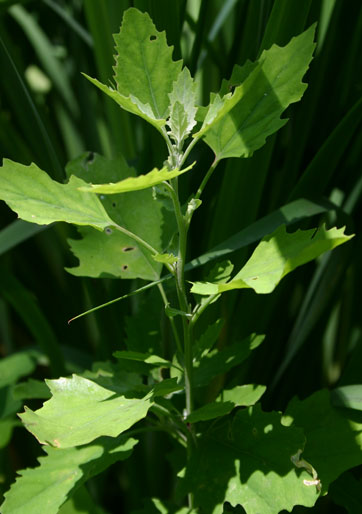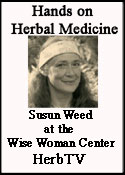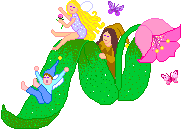Lamb's Quarters - Chenopodium album
by Susun Weed, c. 2009
I told the new apprentice we were having lamb's quarters for dinner.
"I won't have any. I'm a vegetarian," she replied.
With a smile, I corrected myself. "Some people call it fat hen."
"I don't eat chicken either," she responded with a frown.
"It's also called goosefoot," I countered, suppressing a grin.
"Not goose, not even the feet, do I eat," she said with force.
And I agreed, "Pigweed is a more common name for it."
"No matter what kind of animal it is, I am NOT going to eat it," she stated firmly, her eyes shining with fervor and unshed tears.
I confessed, now openly laughing. "It's a weed. A plant. A cooked green!"
Whatever you call it, Chenopodium album and its edible sisters -- there are dozens of useful species -- is a versatile weed that offers incredible amounts of nourishment to those who harvest it instead of cursing it. It is one of the most widely distributed plants  in the world, tolerant of poor soils, high altitudes, and minimal rainfall. Global warming is just fine with lamb's quarters. In higher concentrations of carbon dioxide, it grows almost double in size. And that's good news for those who are in the know about its benefits.
in the world, tolerant of poor soils, high altitudes, and minimal rainfall. Global warming is just fine with lamb's quarters. In higher concentrations of carbon dioxide, it grows almost double in size. And that's good news for those who are in the know about its benefits.
The young, tender leaves of lamb's quarter are tasty in salads. The older leaves, stripped from their stalks and cooked in a small amount of water for thirty minutes or more, are a rich and tasty bone-building green. Left to mature, lamb's quarter plants produce copious amount of protein-rich seeds which are easy to harvest and use. The roots are used as medicine.
The goosefoot family (cheno is goose, pod is foot) includes lamb's quarters, quinoa, spinach, red beets, sugar beets, and Swiss chard (silver beet). Indigenous peoples all over the world have made use of wild goosefoots and cultivated them, too. Chenopodium seed stores have been found in many European neolithic ruins. They were in the ritual meal feed to the Tollund Man 2000 years ago in Denmark.
In North America, Blackfoot Indians used the seeds as early as 1500CE. While both lamb's quarter greens and the seeds are firmly embedded in the cultures and meals of the Navajo, the Pueblo, all the tribes of Arizona, the Diggers of California, and the Iroquois. In South America several tamed-wild goosefoots have been created: Chenopodium quinoa and canahua for their nutritious seeds; huauzoutte for its delicious greens.
I am especially fond of lamb's quarter greens cooked. A half-cup serving (110 grams) contains over 300 mg of calcium. (Swiss chard has 88g, spinach 93g.) And 11,600 IU of vitamin A activity. (Swiss chard has 6500, spinach 8100.) Lamb's quarter greens are also an excellent source of B vitamins, especially riboflavin and folic acid. And they are more than four percent protein.
Lamb's quarter leaves enrich plants as well as people. Bio-dynamic farmers dry them and combine with equal parts dried dandelion, nettle, purslane, sage, and chamomile to make a special plant food for the autumn garden.
Depending on where you live, it may be too late to enjoy lamb's quarters greens right now. Lamb's quarters is an annual, so it doesn't last long once it has put out its tiny green flowers. But you can probably still harvest lamb's quarter seeds.
I harvest protein- and mineral-rich lamb's quarter for seed in September and early October here in the Catskills. I cut the plants low to the ground and immediately put them -- heads down -- in paper bags.
When I have harvested all I want, I lay fresh paper or an old sheet on the floor, take the plants out of the paper bags, and hang them -- still heads down -- above. The seeds that fall out as the plants dry are easy to collect. I use my hands to release the seeds that don't fall out. I dehydrate the seeds in a very slow oven (110F), let them cool completely, then store them, chaff and all, in a tightly sealed glass jar.
I cook lamb's quarter seeds in with any grain that I make, such as brown rice, kasha, even quinoa. I stir lamb's quarter seeds (and nettle seeds and plantain seeds) into my morning oatmeal when I put it up to boil. I sprinkle lamb's quarter seeds to pancakes and muffins and cornbread. I add lamb's quarter seeds to soups, sauteing them with the onion at the beginning of the soup making. I throw lamb's quarter seeds into my tomato sauce, where they add so much flavor and protein that some people swear I've used meat in my sauce.
Lamb's quarter seeds are totally safe to eat, but there are two cautions to keep in mind when eating lamb's quarter leaves. All edible plants in this family -- including spinach and chard -- concentrate oxalic acid in the leaves. And oxalic acid can interfere with calcium utilization unless eating with a good source of calcium, such as cheese or yogurt, at the same meal. The roots of lamb's quarter search out and concentrate nitrogen (protein), plants growing in fields that have been heavily fertilized (with chemical fertilizers) can contain large amount of nitrites and nitrates. Fertilized plants have harmed livestock and, theoretically, could harm us.
Green blessings are all around you. And a gardener's best revenge is to eat the weeds, especially lamb's quarter..
~ Susun Weed

Herb Salt
Lamb's quarter leaves are so mineral-rich that they can be used alone as a salt substitute. But adding aromatic herbs enlivens the taste. Adding seaweed not only makes this herb salt salty, it increases the nutritive benefits.
1 part dried lamb's quarter leaves
1 part dried thyme or rosemary
1 part dried dill or celery leaves
1 part dried marjoram or oregano
2 parts dried seaweed (Nereocystis kelp is the best)
Gently toast seaweed in a cast iron skillet until very crisp. Grind each herb in a coffee mill while seaweed cools. Then grind seaweed and combine with ground herbs. Store in a shaker.
Zuni Steamed Dumplings
From Carolyn Niethammer's American Indian Food and Lore (c. 1974). An easy and delicious wild food addition to any casserole, stew or soup.
Combine 1/2 cup cold water and 1/2 cup cornmeal with 1/2 teaspoon salt. Add slowly to 1 1/2 cups boiling water. Cover and thicken over low heat. Remove from heat and add 1/2 cup ground lamb's quarter seeds. Form into small balls. Place on a rack over boiling water and steam for 15-20 minutes, or until done. Add to a casserole, stew, or soup and cook gently for another half hour before serving.
Hands On Herbal Medicine 2 DVD set
 Hands On Herbal Medicine
Hands On Herbal Medicine
First Susun Weed leads her students on a walk around her land at the Wise Woman Center. She teaches about plant and animal cells, nourishing herbal infusions, digestive fire and grounding. Herbs discussed include mitchella, hemlock, sheep sorrel, white pine, nettles, and mushroom turkey tail. In the second part, Susun teaches about preparing herbs for use. The five menstruums she uses are honey, water, vodka, oil, and vinegar. Each one is explained and demonstrated. Herbs discussed include catnip, ginko, shiso, nettle, and wormwood.
Time: Part 1 - 1 hr 22 min Part 2 - 1 hr 28 min.
Produced in 2009 by HerbTV Studio
Order Hands On Herbal Medicine DVD in our Bookshop

 in the world, tolerant of poor soils, high altitudes, and minimal rainfall. Global warming is just fine with lamb's quarters. In higher concentrations of carbon dioxide, it grows almost double in size. And that's good news for those who are in the know about its benefits.
in the world, tolerant of poor soils, high altitudes, and minimal rainfall. Global warming is just fine with lamb's quarters. In higher concentrations of carbon dioxide, it grows almost double in size. And that's good news for those who are in the know about its benefits.


